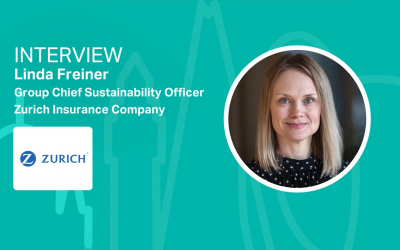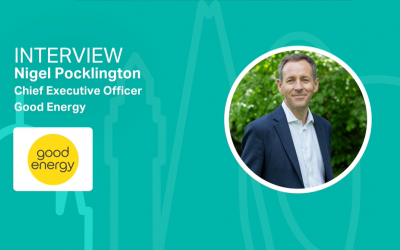Sarah Wilson on Scaling Climate Finance in a Shifting Political Landscape
Sarah Wilson, Managing Director, Head of Climate Center of Excellence at Nuveen, spoke to Climate Action following the Climate Innovation Forum during London Climate Action Week. She shared why a long-term outlook and pragmatic engagement are key to advancing climate resilience and scaling sustainable finance.
.png)
What lessons have emerged over the past year that are reshaping how investors approach climate risk and resilience?
It’s been a whirlwind in the climate space over the last year. I can think of three lessons learned, which are the importance of emphasizing the long term, leading with the investment case and focusing on what we do invest in, not just what we don’t.
Emphasizing the long-term: Many of our clients, including our largest client and parent company TIAA, are investors with perpetual time horizons. This has become increasingly important in the approach to the low carbon transition as we weather the short-term ups and downs of the political cycle. We continue to believe that climate change itself, along with the economics associated with low carbon technologies, will drive decarbonization over time. However, just like any other investment risk or opportunity, it requires investors to use a robust process to pick winners and avoid losers. Simply going all-in on certain technologies or sectors is not likely to deliver best results.
Leading with investment case: While some clients choose responsible investing strategies for values alignment, we have always emphasized that Nuveen’s responsible investment strategies seek to deliver competitive risk-adjusted returns alongside other benefits. These strategies have a particular emphasis on impact, sustainability or ESG leadership. This year, Nuveen crossed the $100 billion mark in responsible investing-aligned strategies.
Focusing on the positive: Much of the climate finance and decarbonization space has focused on reducing exposure to high carbon investments in the last five years. While we will continue to offer funds that avoid exposure to sectors like fossil fuels, we are encouraged to see the conversation starting to pivot toward allocating capital to climate solutions. I’ve spent much of the last year helping build market frameworks to make climate solutions investing easier, such as with the Global Impact Investing Network’s Climate Solutions Investing framework, which recently launched during London Climate Week.
Where do you think the biggest opportunities lie for scaling up climate finance across both public and private markets?
Despite the U.S. administration’s pronounced shift in tone on environmental action, investors have shown sustained interest in tackling climate change through investments. This has been across many asset classes and investment vehicles which feed into the transition to a low carbon economy.
There has been particular attention on private credit investments, such as energy infrastructure credit and the real estate focused Commercial Property-Assessed Clean Energy (C-PACE) loans. Both offer debt exposures to climate solutions, like energy efficiency and renewable energy, but in different ways.
Energy infrastructure credit lets investors gain credit exposure to the energy transition within private markets. Themes like decarbonization, circular economy and digitalization come together in this strategy. This has drawn the interest of global institutional clients with a focus on sustainability. Nuveen’s strategy invested, for example, in SunZia, the largest clean energy infrastructure project in U.S. history. SunZia includes a wind farm in New Mexico and a transmission line to carry wind power to Arizona and California.1
C-PACE finances climate solutions in the built environment within commercial real estate and is enabled by policy at the U.S. state level. Today, more than 40 U.S. states allow C-PACE financing, and we are engaging internationally to bring the same structure to new jurisdictions. Many of our insurance clients are drawn to C-PACE because it offers stable returns similar to other fixed income exposures, but with more attractive yield.
On the public side, the green, social and sustainability bond market is continuing to grow. This is a critical source of capital for corporates and governments to fund their low carbon ambitions. Nuveen was one of the earliest investors in this market and continues to be known as an innovator willing to anchor landmark transactions, like the recent Amazon reforestation bond issued by the World Bank. Credibility is important in this market; we focus on direct and measurable positive impact through use of proceeds and transparent impact reporting for our public fixed income impact strategies. We won best impact report of the year from Environmental Finance last year, so our approach is getting traction.2
How are institutions managing to stay committed to climate goals amid ongoing economic uncertainty and political tension?
It’s important to remember that climate goals, such as net zero targets, are not short term. These are long-term journeys that require pragmatism and flexibility. While there has been a significant shift in sentiment toward sustainability goals, particularly in the U.S., commitments are made with timeframes that extend beyond one political cycle.
However, we have seen some public companies rolling back on commitments related to climate action. In these circumstances, we engage with management to better understand where the company is on its journey and meet them where they are – whether that’s asking for additional transparency, accountability or impact.
At TIAA and Nuveen, we have remained committed to our net zero goals (net zero by 2050 for the TIAA General Account and by 2040 for Nuveen Real Estate and TIAA/Nuveen corporate operations). We have taken a pragmatic approach to interim target-setting, with ranges for targets and asset class-specific metrics, which allow for flexibility. We are also transparent about what’s required for net zero, such as government action and grid decarbonization, and have published our own research tracking the pace of the energy transition to help us (and our clients) make decisions.3
How do you see investor engagement evolving when it comes to influencing corporate or sector-level climate transitions?
Engagement tactics will likely evolve into sector-specific best practices that can be applied across groups of peer companies. The need for collaboration with experts outside the finance sector will also likely become more important, as climate mitigation best practices get more technical.
For instance, we have been working with our partners at the Environmental Defense Fund (EDF) to grow energy company participation in the Oil & Gas Methane Partnership 2.0. This includes among the national oil companies in which we hold debt positions. We see reducing methane emissions as one of the most logical and urgent climate mitigation priorities since existing technology is both available and cost-effective.
Within the banking sector, we’ve worked with EDF and other partners to encourage disclosure of their energy supply financing ratio. This ratio shares the relative mix of clean energy and fossil fuel energy financed by the banks. Several banks, including J.P. Morgan, have now started to calculate and share publicly.4
1https://patternenergy.com/projects/sunzia/
3https://www.nuveen.com/global/insights/equilibrium/the-energy-transition?type=global
These materials are provided solely for use in private meetings and are intended for informational and discussion purposes only. These materials are only for use by the intended party and may only be circulated only to persons whom they may lawfully be distributed. Persons who do not fall within such descriptions may not act upon the information contained in these materials. Any entity responsible for forwarding this material to other parties takes responsibility for ensuring compliance with local laws, and in particular any applicable financial promotion rules.
The information presented in these materials is believed to be materially correct as at the date hereof, but no representation or warranty (express or implied) is made as to the accuracy or completeness of any of this information. Data was taken from sources deemed reliable, but cannot guarantee its accuracy. The statements contained herein reflect opinions as of the date written and are subject to change without further notice. Nothing set out in these materials is or shall be relied upon as a promise or representation as to the past or future.
This document is not a prospectus and does not constitute an offer to the public. No public offering or advertising of investment services or securities is intended to have taken effect through the provision of these materials. It is not intended to provide specific investment advice including, without limitation, investment, financial, legal, accounting or tax advice, or to make any recommendations about suitability for any particular investor.
Nuveen, LLC provides investment solutions through its investment specialists. Nuveen Securities, LLC, member FINRA and SIPC.






